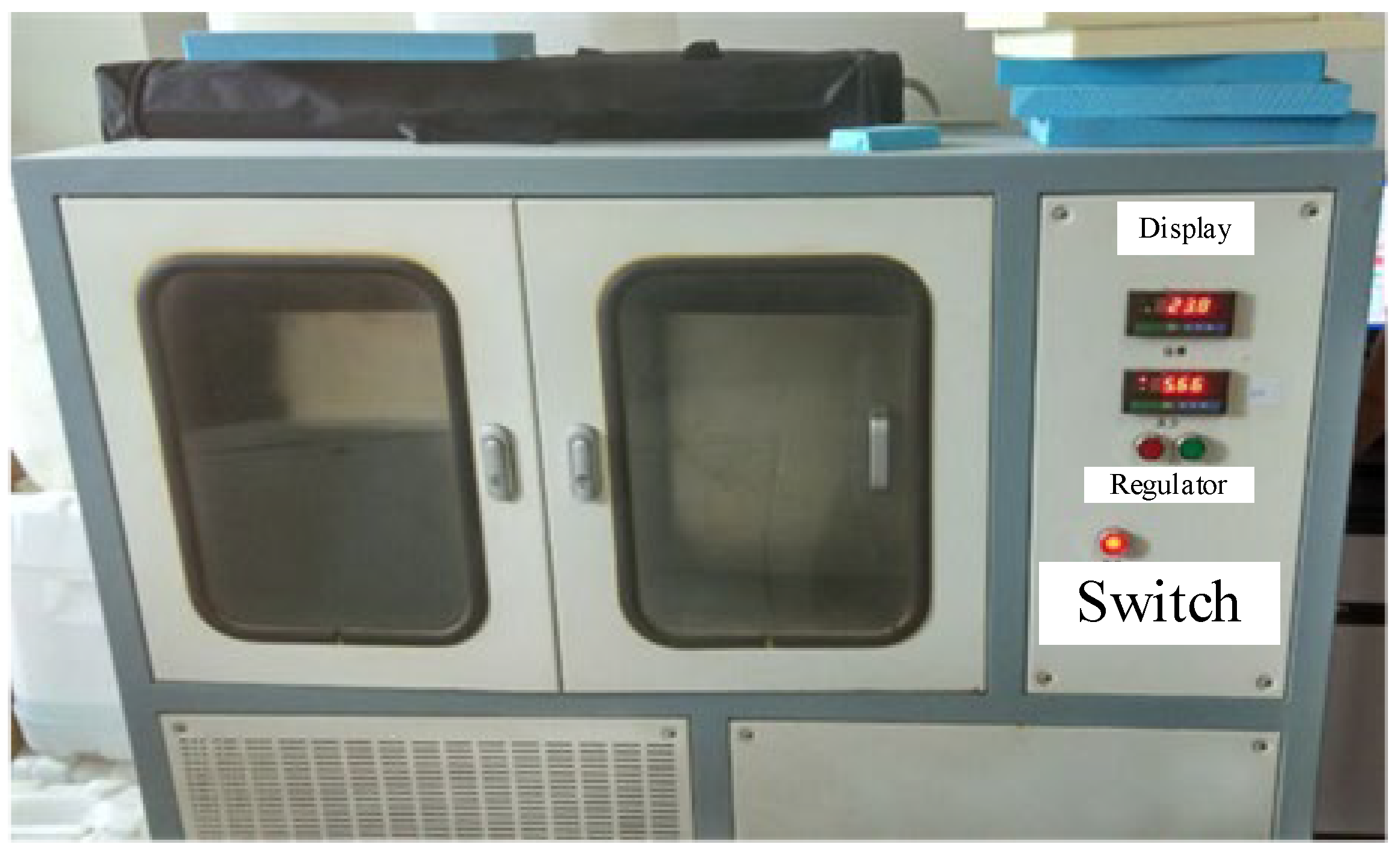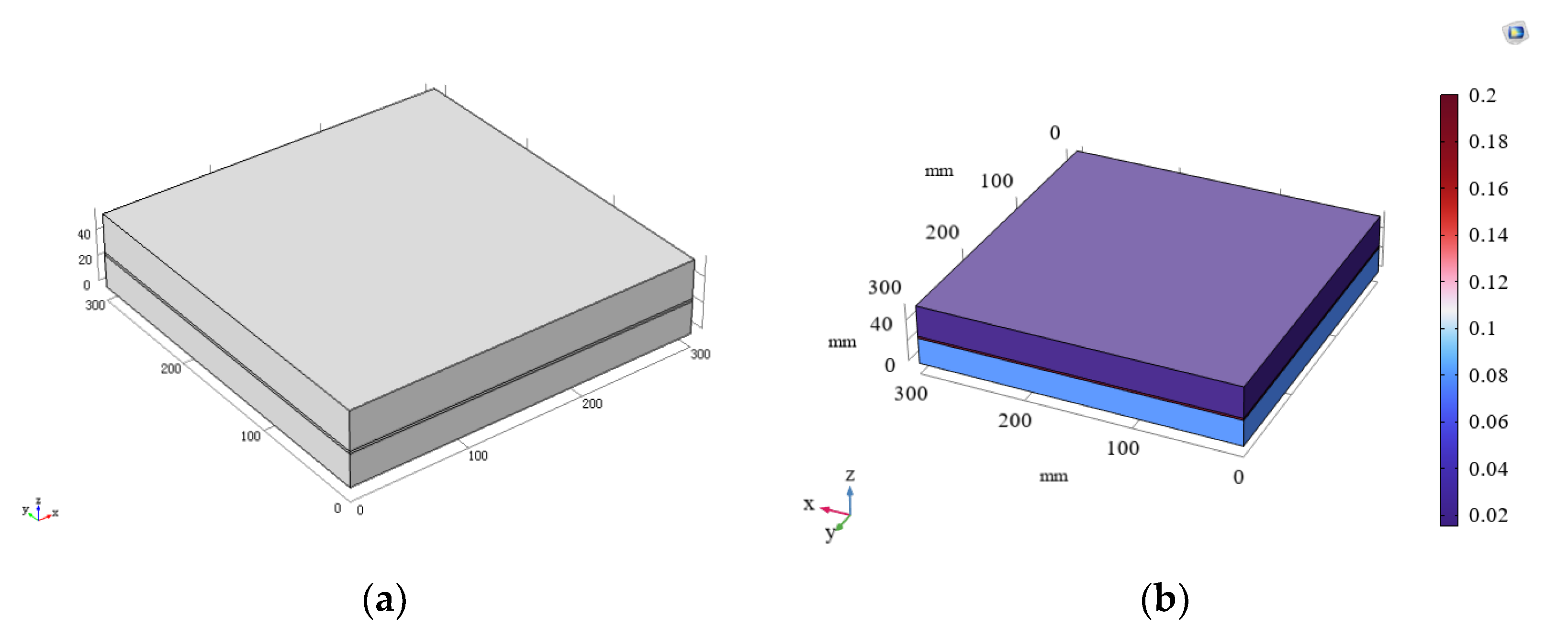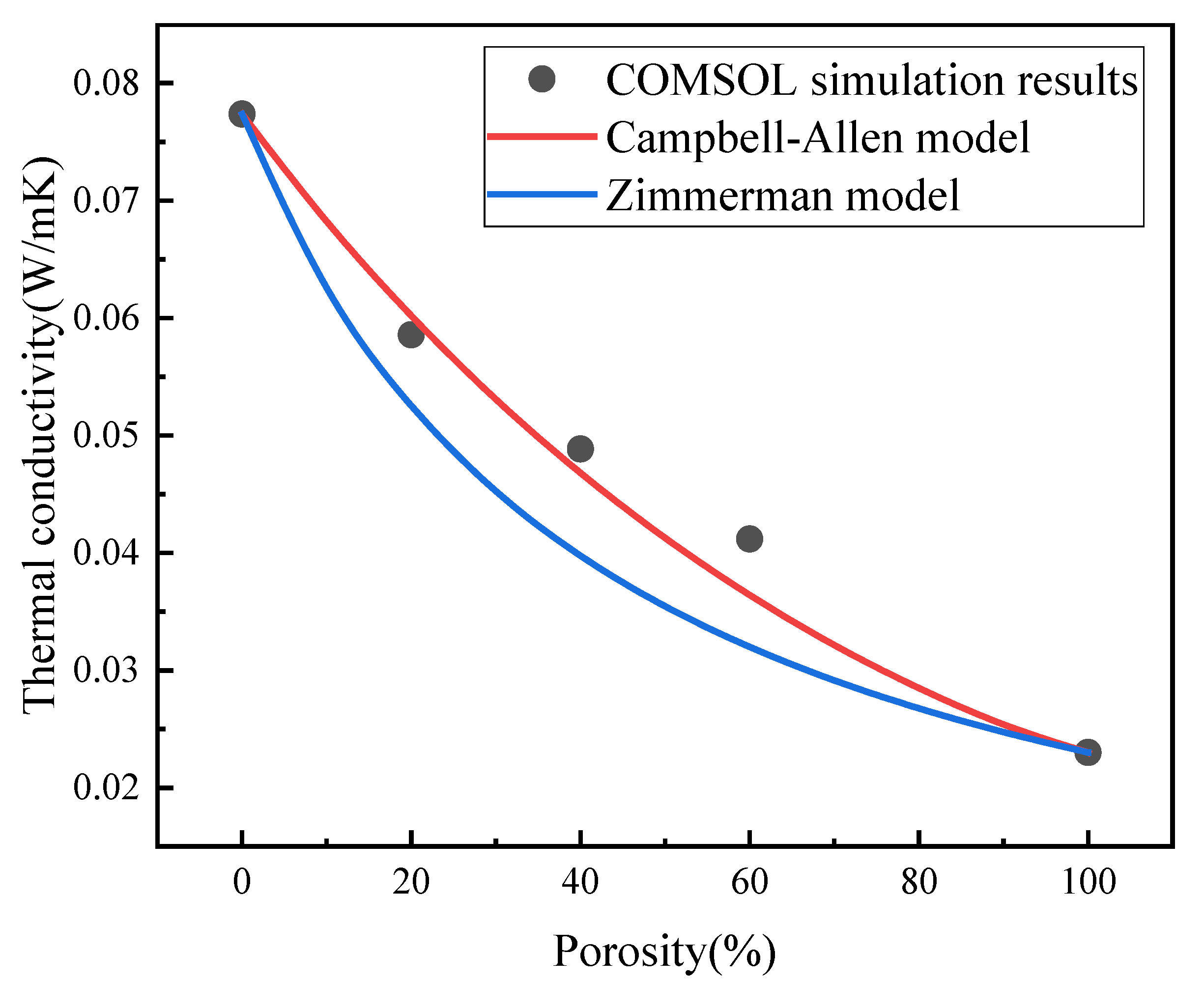Evolution Law of Structural Form and Heat Transfer Performance of Thermal Insulation System
Abstract
:1. Introduction
2. Overview of Thermal Insulation Materials
2.1. Rigid Polyurethane Foam
- (1)
- Regularly arranged closed pores. This is the main form of RPUF, and the pore size is approximately 50 nm. The existence of these closed pores allows foamed plastics to exhibit good thermal insulation performance. However, the cell wall can absorb the foaming agent gas inside the cell, which can affect the thermal conductivity of the material.
- (2)
- Irregular-shaped vesicles with no obvious hybrid structure. This structure often occurs due to local polymerization and imperfect foaming processes, resulting in dead zones.
2.2. Foam Concrete
- (1)
- Light weight: foamed concrete has a low density which typically ranges from 300 kg/m3 to 1200 kg/m3.
- (2)
- Good insulation performance: foamed concrete contains a large number of closed, uniform, and fine circular pores which contribute to its excellent insulation performance.
- (3)
- Excellent sound insulation performance: as a porous material, foamed concrete contains a large number of closed pores, which leads to superior sound insulation performance.
- (4)
- Non-flammable and high-temperature resistant: Cement is the main raw material of foamed concrete and is classified as a class a fireproof material.
- (5)
- Environmental benefits: foamed concrete can be mixed with industrial waste during the production process, enabling the effective use of waste resources and contributing to environmental protection efforts.
2.3. Vacuum Insulation Panels
2.4. Materials and Test Method
3. Numerical Simulation
3.1. Relationship between Porosity and Thermal Conductivity
3.2. Calculation of Thermal Conductivity of Composite Materials
3.3. Finite Element Software Simulation
4. Results and Discussion
4.1. Calculation Thermal Conductivity of Composite Materials
4.2. Influence of Porosity on Thermal Conductivity
5. Engineering Application and Design
6. Conclusions
- (1)
- By simulating the distribution of the pore structure, it is possible to qualitatively analyze the influence of pore structure and pores on the heat transfer path and thermal conductivity of insulation materials.
- (2)
- The thermal conductivity of composite insulation materials can be obtained through theoretical calculation formulas and numerical simulation methods. When combined with experimental results, it can be seen that the thermal conductivity values calculated using the numerical simulation method are in good agreement with experimental data.
- (3)
- In practical engineering, the gap width between materials can affect the overall heat transfer coefficient of the component. Through numerical simulation methods, the optimal gap width can be determined to be 60 mm.
Author Contributions
Funding
Institutional Review Board Statement
Informed Consent Statement
Data Availability Statement
Conflicts of Interest
References
- Ding, Y.; Ye, X.W.; Guo, Y. Data set from wind, temperature, humidity and cable acceleration monitoring of the Jiashao bridge. J. Civ. Struct. Health Monit. 2023, 13, 579–589. [Google Scholar] [CrossRef]
- Ding, Y.; Ye, X.W.; Guo, Y. Wind load assessment with the JPDF of wind speed and direction based on SHM data. Structures 2023, 47, 2074–2080. [Google Scholar] [CrossRef]
- Ding, Y.; Ye, X.W.; Guo, Y. A multi-step direct and indirect strategy for predicting wind direction based on EMD-LSTM model. Struct. Control Health Monit. 2023, 2023, 4950487. [Google Scholar] [CrossRef]
- Ding, Y.; Hang, D.; Wei, Y.-J.; Zhang, X.-L.; Ma, S.-Y.; Liu, Z.-X.; Zhou, S.-X.; Han, Z. Settlement prediction of existing metro induced by new metro construction with machine learning based on SHM data: A comparative study. J. Civ. Struct. Health Monit. 2023, 13, 1–11. [Google Scholar] [CrossRef]
- Ding, Y.; Ye, X.-W.; Guo, Y.; Zhang, R.; Ma, Z. Probabilistic method for wind speed prediction and statistics distribution inference based on SHM data-driven. Probabilistic Eng. Mech. 2023, 73, 103475. [Google Scholar] [CrossRef]
- Ding, Y.; Ye, X.W.; Guo, Y. Copula-based JPDF of wind speed, wind direction, wind angle and temperature with SHM data. Probabilistic Eng. Mech. 2023, 73, 103483. [Google Scholar] [CrossRef]
- Ding, Y.; Ye, X.W.; Ding, Z.; Wei, G.; Cui, Y.-L.; Jin, T. Short-term tunnel-settlement prediction based on Bayesian wavelet: A probability analysis method. J. Zhejiang Univ. Sci. 2023, in press. [Google Scholar] [CrossRef]
- Ding, Y.; Ye, X.-W.; Su, Y.-H.; Zheng, X.-L. A framework of cable wire failure mode deduction based on Bayesian network. Structures 2023, 57, 104996. [Google Scholar] [CrossRef]
- Cheng, Y.S.; Li, R.; Woo, C.K. Regional energy-growth nexus and energy conservation policy in china. Energy 2021, 217, 119414. [Google Scholar] [CrossRef]
- Yang, Y.Y.; Wu, W.D.; Fu, S.Y.; Zhang, H. Study of a novel ceramsite-based shape-stabilized composite phase change material (pcm) for energy conservation in buildings. Constr. Build. Mater. 2020, 246, 118479. [Google Scholar] [CrossRef]
- Maiolo, M.; Pirouz, B.; Bruno, R.; Palermo, S.A.; Arcuri, N.; Piro, P. The role of the extensive green roofs on decreasing building energy consumption in the mediterranean climate. Sustainability 2020, 12, 359. [Google Scholar] [CrossRef]
- Ma, J.J.; Liu, L.Q.; Su, B.; Xie, B.C. Exploring the critical factors and appropriate polices for reducing energy consumption of china’s urban civil building sector. J. Clean. Prod. 2015, 103, 446–454. [Google Scholar] [CrossRef]
- Ma, X.; Tu, R.; Ding, C.; Zeng, Y.; Wang, Y.; Fang, T. Thermal and fire risk analysis of low pressure on building energy conservation material flexible polyurethane with various inclined facade constructions. Constr. Build. Mater. 2018, 167, 449–456. [Google Scholar] [CrossRef]
- Yaghoobian, N.; Srebric, J. Influence of plant coverage on the total green roof energy balance and building energy consumption. Energy Build. 2015, 103, 1–13. [Google Scholar] [CrossRef]
- Acua, P.; Zhang, J.; Yin, G.Z.; Liu, X.Q.; Wang, D.Y. Bio-based rigid polyurethane foam from castor oil with excellent flame retardancy and high insulation capacity via cooperation with carbon-based materials. J. Mater. Sci. 2021, 56, 2684–2701. [Google Scholar] [CrossRef]
- Cheng, J.; Niu, S.; Ma, D.; Zhou, Y.; Chen, X. Effects of ammonium polyphosphate microencapsulated on flame retardant and mechanical properties of the rigid polyurethane foam. J. Appl. Polym. Sci. 2020, 137, 4959. [Google Scholar] [CrossRef]
- Dhasindrakrishna, D.K.; Pasupathy, K.; Ramakrishnan, S.; Sanjayan, J.G. Progress, current thinking and challenges in geopolymer foam concrete technology. Cem. Concr. Compos. 2021, 116, 103886. [Google Scholar] [CrossRef]
- Mydin, M. Effective thermal conductivity of foamcrete of different densities. Concr. Res. Lett. 2011, 2, 181–189. [Google Scholar]
- Eltayeb, E.; Xing, M.; Yan, Z.; Youssf, O.; Singh, A. Structural performance of composite panels made of profiled steel skins and foam rubberised concrete under axial compressive loads. Eng. Struct. 2020, 211, 110448. [Google Scholar] [CrossRef]
- Khan, M.I. Factors affecting the thermal properties of concrete and applicability of its prediction models. Build. Environ. 2002, 37, 607–614. [Google Scholar] [CrossRef]
- Li, X.; Peng, C.; Liu, L. Experimental study of the thermal performance of a building wall with vacuum insulation panels and extruded polystyrene foams. Appl. Therm. Eng. 2020, 180, 115801. [Google Scholar] [CrossRef]
- Kwon, J.S.; Jang, C.H.; Jung, H.; Song, T.H. Effective thermal conductivity of various filling materials for vacuum insulation panels. Int. J. Heat Mass Transf. 2009, 52, 5525–5532. [Google Scholar] [CrossRef]
- Xia, R.F.; Chen, Y.F.; Feng, Y.J. A method to measure thermal conductivity of vacuum insulation panel using enhanced extreme learning machine model. J. Therm. Sci. 2020, 29, 113–121. (In Chinese) [Google Scholar] [CrossRef]
- Zach, J.; Novák, V.; Peterková, J.; Bubeník, J. Development of vacuum insulation panels with utilization of organic by-products. Energies 2020, 13, 1165. [Google Scholar] [CrossRef]
- Mao, S.; Kan, A.; Wang, N. Numerical analysis and experimental investigation on thermal bridge effect of vacuum insulation panel. Appl. Therm. Eng. 2020, 169, 114980. [Google Scholar] [CrossRef]
- Wang, H.; Hou, F.; Chang, C. Experimental and computational modeling of thermal conductivity of cementitious syntactic foams filled with hollow glass microspheres. Constr. Build. Mater. 2020, 265, 120739. [Google Scholar] [CrossRef]
- Paciorek-Sadowska, J.; Borowicz, M.; Chmiel, E.; Lubczak, J. Use of a mixture of polyols based on metasilicic acid and recycled pla for synthesis of rigid polyurethane foams susceptible to biodegradation. Int. J. Mol. Sci. 2020, 22, 69. [Google Scholar] [CrossRef]
- Zhu, H.; Xu, S.A. Synthesis and properties of rigid polyurethane foams synthesized from modified urea-formaldehyde resin. Constr. Build. Mater. 2019, 202, 718–726. [Google Scholar] [CrossRef]
- Zhou, Y.; Bu, R.; Yi, L.; Sun, J. Heat transfer mechanism of concurrent flame spread over rigid polyurethane foam: Effect of ambient pressure and inclined angle. Int. J. Therm. Sci. 2020, 155, 106403. [Google Scholar] [CrossRef]
- Bote, S.D.; Narayan, R. Synthesis of biobased polyols from soybean meal for application in rigid polyurethane foams. Ind. Eng. Chem. Res. 2021, 60, 5733–5743. [Google Scholar] [CrossRef]
- Manalo, A. Structural behaviour of a prefabricated composite wall system made from rigid polyurethane foam and magnesium oxide board. Constr. Build. Mater. 2013, 41, 642–653. [Google Scholar] [CrossRef]
- Liu, K.W.; Yue, F.; Su, Q.; Zhou, C.; Xiong, Z.; He, Y. Assessment of the use of fiberglass-reinforced foam concrete in high-speed railway bridge approach involving foundation cost comparison. Adv. Struct. Eng. 2020, 23, 388–396. [Google Scholar] [CrossRef]
- Li, T.; Huang, F.; Zhu, J.; Tang, J.; Liu, J. Effect of foaming gas and cement type on the thermal conductivity of foamed concrete. Constr. Build. Mater. 2020, 231, 117197. [Google Scholar] [CrossRef]
- Qu, Y.; Chen, J.; Liu, L.; Xu, T.; Wu, H.; Zhou, X. Study on properties of phase change foam concrete block mixed with paraffin / fumed silica composite phase change material. Renew. Energy 2020, 150, 1127–1135. [Google Scholar] [CrossRef]
- Lu, Y.; Hu, X.; Yang, X.; Xiao, Y. Comprehensive tests and quasi-brittle fracture modeling of light-weight foam concrete with expanded clay aggregates. Cem. Concr. Compos. 2020, 115, 103822. [Google Scholar] [CrossRef]
- Jiang, C.; Cheng, X. Recycling of waste ceramic foams as fine aggregates in pervious concrete. RSC Adv. 2020, 10, 2364–2367. [Google Scholar] [CrossRef]
- Liu, C.; Luo, J.; Li, Q.; Gao, S.; Jin, Z. Preparation and physical properties of high-belite sulphoaluminate cement-based foam concrete using an orthogonal test. Materials 2019, 12, 984. [Google Scholar] [CrossRef]
- Gonalves, M.; Simes, N.; Serra, C.; Flores-Colen, I. A review of the challenges posed by the use of vacuum panels in external insulation finishing systems. Appl. Energy 2020, 257, 114028. [Google Scholar] [CrossRef]
- Kalns, S.E.; Jelle, B.P. Vacuum insulation panel products: A state-of-the-art review and future research pathways. Appl. Energy 2014, 116, 355–375. [Google Scholar] [CrossRef]
- Mukhopadhyaya, P.; Kumaran, K.; Normandin, N.; Reenen, D.V.; Lackey, J. High performance vacuum insulation panel: Development of alternative core materials. J. Cold Reg. Eng. 2008, 22, 103. [Google Scholar] [CrossRef]
- Wang, L.; Yang, Y.; Chen, Z.; Hong, Y.; Wu, J. Preparation and characterization of a type of green vacuum insulation panel prepared with straw core material. Materials 2020, 13, 4604. [Google Scholar] [CrossRef] [PubMed]
- Zhou, S.X.; Ding, Y.; Wang, Z.P.; Dong, J.L.; She, A.M.; Wei, Y.Q. Weathering of roofing insulation materials under multi-field coupling conditions. Materials 2019, 12, 3348. [Google Scholar] [CrossRef]
- Fricke, J.; Schwab, H.; Heinemann, U. Vacuum insulation panels—Exciting thermal properties and most challenging applications. Int. J. Thermophys. 2006, 27, 1123–1139. [Google Scholar] [CrossRef]
- Tao, W.H.; Sun, J.Y. Simulation and experimental study on the air flow and heat loads of different refrigerator cabinet designs. Chem. Eng. Commun. 2001, 186, 171–182. [Google Scholar] [CrossRef]
- Campbell-Allen, D.; Thorne, C.P. The thermal conductivity of concrete. Mag. Concr. Res. 1963, 15, 39–48. [Google Scholar] [CrossRef]
- Zimmerman, R.W. Thermal conductivity of fluid-saturated rocks. J. Pet. Sci. Eng. 1989, 3, 219–227. [Google Scholar] [CrossRef]
- Ding, Y.; Zhou, S.X.; Huang, S.E.; Wang, Z.P.; Wei, Y.Q. Determination of thermal conductivity coefficient of composite materials based on 3D simulation of COMSOL. Transducer Microsyst. Technol. 2018, 37, 112–113, 116. (In Chinese) [Google Scholar] [CrossRef]
- Ding, Y.; Yang, T.L.; Liu, H.; Han, Z.; Zhou, S.X.; Wang, Z.P.; She, A.M.; Wei, Y.Q.; Dong, J.L. Experimental study and simulation calculation of the chloride resistance of concrete under multiple factors. Applied. Sci. 2021, 11, 5322. [Google Scholar] [CrossRef]
- Zhou, S.X.; Han, Z.; Yu, L.H.; Wei, X.; Wei, Y. Influence of random aggregates on diffusion behavior of chloride ions in concrete based on comsol simulation. Compos. Mech. 2018, 9, 1–16. [Google Scholar] [CrossRef]
- Ding, Y.; Dong, J.L.; Yang, T.L.; Wang, Z.P.; Zhou, S.X.; Wei, Y.Q.; She, A.M. Microscopic experimental analysis on weatherability of roof insulation materials under multi field coupling environment. Mater. Res. Express 2021, 8, 035504. [Google Scholar] [CrossRef]










| Number | Material | Measured Thermal Conductivity (W/mK) | Specific Heat Capacity (J/kgK) | Density (kg/m3) |
|---|---|---|---|---|
| 1 | 25 mm FC | 0.077382 | 1050 | 247 |
| 2 | 30 mm RPUF | 0.015302 | 1380 | 39.15 |
| 3 | 15 mm RPUF | 0.018608 | 1380 | 39.15 |
| 4 | 2 mm mortar | 0.2 | 1320 | 800 |
| 5 | 15 mm VIP | 0.00669 | 1280 | 196.48 |
| 6 | 100 mm FC | 0.077382 | 1050 | 247 |
| Composite Material Scheme | Measured Thermal Conductivity (W/mK) |
|---|---|
| Scheme 1 | 0.034557 |
| Scheme 2 | 0.039583 |
| Scheme 3 | 0.014944 |
| Scheme 4 | 0.018104 |
| Composite Material Scheme | Simulated Thermal Conductivity (W/mK) | Relative Error (%) |
|---|---|---|
| Scheme 1 | 0.033865 | 2.002 |
| Scheme 2 | 0.037942 | 4.145 |
| Scheme 3 | 0.015316 | 2.487 |
| Scheme 4 | 0.018605 | 2.767 |
| Composite Material Scheme | Simulated Thermal Conductivity (W/mK) | Relative Error (%) |
|---|---|---|
| Scheme 1 | 0.0248517 | 28.08 |
| Scheme 2 | 0.0368687 | 6.86 |
| Scheme 3 | 0.010463 | 29.98 |
| Scheme 4 | 0.016032 | 11.425 |
| Materials | Thickness (mm) | Measured Thermal Conductivity (W/mK) | Specific Heat Capacity (J/kgK) | Density (kg/m3) |
|---|---|---|---|---|
| 304 stainless steel | 0.8 | 16.28 | 7850 | 500 |
| RPUF | 30 | 0.025 | 39.15 | 1380 |
| VIP | 20 + 20 | 0.0025 | 196.48 | 1280 |
| RPUF | 30 | 0.025 | 39.15 | 1380 |
| 304 stainless steel | 0.8 | 16.28 | 7850 | 500 |
| Gap Width (mm) | Heat Flux (W/m2) | Temperature Gradient (K/m) | Thermal Conductivity (W/mK) | Heat Transfer Coefficient (W/K) |
|---|---|---|---|---|
| 0 | 1.4096 | 240 | 0.005873 | 0.058733 |
| 10 | 1.6155 | 248.13 | 0.006511 | 0.065107 |
| 20 | 1.8466 | 256.03 | 0.007212 | 0.072124 |
| 30 | 2.0533 | 263.66 | 0.007788 | 0.077877 |
| 40 | 2.2494 | 271.12 | 0.008297 | 0.082967 |
| 50 | 2.4395 | 278.48 | 0.00876 | 0.087601 |
| 60 | 2.6266 | 285.77 | 0.009191 | 0.091913 |
| 70 | 2.812 | 293.03 | 0.009596 | 0.095963 |
| 80 | 2.9957 | 300.27 | 0.009977 | 0.099767 |
| 90 | 3.1798 | 307.48 | 0.010341 | 0.103415 |
| 100 | 3.363 | 314.69 | 0.010687 | 0.106867 |
| 110 | 3.5462 | 321.9 | 0.011016 | 0.110165 |
| 120 | 3.729 | 329.11 | 0.011331 | 0.113306 |
| 130 | 3.9123 | 336.3 | 0.011633 | 0.116334 |
| 140 | 4.0949 | 343.51 | 0.011921 | 0.119208 |
| 150 | 4.2777 | 350.72 | 0.012197 | 0.121969 |
| 160 | 4.4609 | 357.91 | 0.012464 | 0.124637 |
| 170 | 4.6439 | 365.11 | 0.012719 | 0.127192 |
| 180 | 4.8267 | 372.31 | 0.012964 | 0.129642 |
| 190 | 5.0094 | 379.51 | 0.0132 | 0.131997 |
| 200 | 5.1924 | 386.71 | 0.013427 | 0.134271 |
Disclaimer/Publisher’s Note: The statements, opinions and data contained in all publications are solely those of the individual author(s) and contributor(s) and not of MDPI and/or the editor(s). MDPI and/or the editor(s) disclaim responsibility for any injury to people or property resulting from any ideas, methods, instructions or products referred to in the content. |
© 2023 by the authors. Licensee MDPI, Basel, Switzerland. This article is an open access article distributed under the terms and conditions of the Creative Commons Attribution (CC BY) license (https://creativecommons.org/licenses/by/4.0/).
Share and Cite
Zhou, S.-X.; Li, J.-X.; Bao, S.-F.; Ding, Y.; Wei, Y.-Q.; She, A.-M.; Guo, Z.-Z.; Dong, J.-L. Evolution Law of Structural Form and Heat Transfer Performance of Thermal Insulation System. Materials 2023, 16, 6341. https://doi.org/10.3390/ma16186341
Zhou S-X, Li J-X, Bao S-F, Ding Y, Wei Y-Q, She A-M, Guo Z-Z, Dong J-L. Evolution Law of Structural Form and Heat Transfer Performance of Thermal Insulation System. Materials. 2023; 16(18):6341. https://doi.org/10.3390/ma16186341
Chicago/Turabian StyleZhou, Shuang-Xi, Jian-Xin Li, Shu-Feng Bao, Yang Ding, Yong-Qi Wei, An-Ming She, Zhen-Zhen Guo, and Jing-Liang Dong. 2023. "Evolution Law of Structural Form and Heat Transfer Performance of Thermal Insulation System" Materials 16, no. 18: 6341. https://doi.org/10.3390/ma16186341






